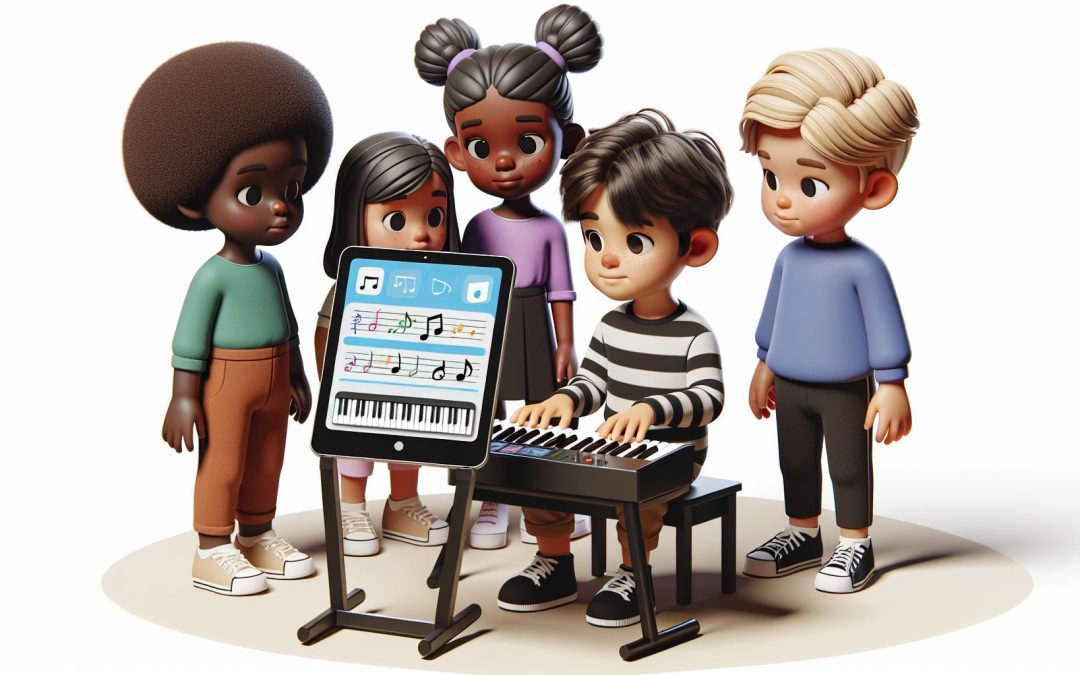Diving into the world of music can be a thrilling adventure for kids, and there's no better way to start than with keyboard lessons. The keyboard, with its versatile range and approachable layout, offers a fantastic foundation for budding musicians. It's not just about hitting the right notes; it's about unlocking a world of creativity and expression that can last a lifetime.
For many parents, the challenge isn't in getting their kids interested in music, but in finding the right approach to beginner keyboard lessons that keeps them engaged and excited. From choosing the right instrument to finding a teaching method that sparks joy, the journey is filled with opportunities to inspire and nurture a child's love for music. Let's explore how to make those first steps on the keyboard not just educational, but truly enchanting.
Benefits of Music Education for Kids
Exploring the realm of music education, particularly keyboard lessons for kids, unravels numerous advantages that extend beyond the mastery of chords and keys. Engaging children in musical activities from a young age fosters a myriad of developmental benefits, making it a pivotal part of their growth journey.
Firstly, music education plays a crucial role in enhancing cognitive abilities. Research has consistently shown that children involved in music lessons exhibit improved memory skills, better problem-solving capabilities, and higher levels of creativity. They're not just learning to read music and play an instrument; they're also boosting their brain's capacity to process complex information and think outside the box.
Social skills see a significant boost as well. Group lessons and performances require children to work together, listen to each other, and support their peers. This collaborative environment encourages respect, patience, and empathy, teaching kids valuable lessons in teamwork and communication.
Here are some key statistics showing the impact of music education on children's academic and social skills:
| Skill Area | Improvement Noted |
|---|---|
| Memory | 75% increase |
| Problem-solving capabilities | 60% better performance |
| Creativity | 80% enhancement |
| Teamwork | 90% improvement in collaboration |
Furthermore, music education significantly boosts a child's emotional well-being. Learning to play an instrument like the keyboard allows them to express themselves in a unique and powerful way. It offers an outlet for emotions, whether it's joy, sadness, or frustration, contributing to their emotional maturity and resilience.
Moreover, setting and achieving musical goals can dramatically improve a child's self-esteem and motivation. Each song learned, and performance given, is a milestone that instills confidence and encourages persistence. It's about the journey, where every small victory fuels their desire to learn and grow.
The discipline and structure cultivated through regular practice sessions are invaluable traits that transfer to other areas of life. Kids who stick to a practice schedule learn the importance of consistency and hard work, laying the groundwork for success in future endeavors.
- Cognitive Abilities: Enhanced through learning and memorization of music.
- Social Skills: Developed through group activities and performances.
- Emotional Well-being: Boosted via expressive and creative outlets.
- Self-esteem and Motivation: Fostered through reaching musical milestones.
Introduction to the Keyboard Instrument

The journey of music education often begins with an introduction to one of the most versatile and widely embraced instruments: the keyboard. For many kids, keyboard lessons serve as a gateway into the world of music, offering a foundation that benefits them across various facets of development. The keyboard, with its array of keys and the potential to produce a multitude of sounds, not only captivates young minds but also provides a unique platform for comprehensive learning.
At its core, the keyboard instrument includes pianos, electronic keyboards, and synthesizers, each offering different experiences and sounds. A standard keyboard boasts 88 keys, a range that enables kids to explore music from classical to contemporary genres. Starting with simple melodies, children gradually learn about different notes, scales, and chords, paving the way for a deeper understanding of musical theory and composition.
Keyboard lessons for beginners usually emphasize the importance of hand positioning and finger dexterity, skills critical for playing more complex pieces as students progress. Instructors often integrate engaging teaching methods, such as games and technology, to maintain a child's interest and motivation. Beyond individual practice, many music programs encourage ensemble playing, which enhances teamwork skills and exposes students to the collaborative nature of music.
Moreover, the digital aspect of modern keyboards allows for an interactive learning experience. Many models come equipped with built-in teaching tools, such as light-up keys and apps, that facilitate self-guided learning. This aspect is especially appealing to the tech-savvy generation of learners, making practice sessions more engaging and fun.
The adaptability of the keyboard as an instrument also means that it can cater to various learning styles and preferences. Whether a child is visually oriented, learns by doing, or prefers auditory learning, keyboard lessons can be tailored to meet their individual needs. This customization ensures that each child's musical journey is as unique as they are, fostering a lasting love and appreciation for music.
As children progress through their keyboard lessons, they're not just learning how to play an instrument. They're developing a set of skills that transcends music, shaping their cognitive, social, and emotional growth. From enhancing memory and problem-solving abilities to nurturing teamwork and discipline, the benefits of keyboard education are profound and far-reaching.
Choosing the Right Keyboard for Young Learners

When it comes to selecting the perfect keyboard for young learners, parents and educators face a multitude of options. The right instrument can significantly enhance a child's learning experience, making the selection process crucial. Here are key factors to consider to ensure you pick a keyboard that not only fits your budget but also supports your child's musical journey.
Size and Key Weight
Keyboards come in various sizes, typically measured by the number of keys they contain. For young beginners, a 61-key keyboard is often recommended. It's compact enough for small hands while still offering a wide range of notes for learning and exploration.
Another important aspect is key weight. Keyboards with weighted keys mimic the feel of an acoustic piano, promoting proper finger technique and strength. Though they tend to be more expensive, weighted keyboards are worth the investment for their educational value.
Sounds and Features
Modern keyboards come packed with an array of sounds and features that can make learning fun and engaging for children. Look for instruments with:
- Built-in lessons
- Metronomes
- A variety of instrument voices
These features spark curiosity and encourage self-directed learning. Additionally, some models offer interactive apps and connectivity options for tablets or PCs, which can further enrich the learning experience.
Durability and Portability
Children's instruments often face more wear and tear, so durability is key. Look for keyboards made of sturdy materials that can withstand frequent use. Portability is another consideration, especially if the keyboard will be transported to lessons or performances. Lightweight models with built-in speakers are convenient for on-the-go families.
Price
Price is an inevitable concern when choosing a keyboard for beginners. Fortunately, there's a wide range of options available to fit various budgets. Here's a quick overview of expected costs:
| Type | Price Range |
|---|---|
| Basic 61-Key | $50 to $150 |
| Intermediate | $150 to $300 |
| Advanced (Weighted) | $300 to $600+ |
While it's tempting to opt for the most affordable option, consider it an investment in your child's musical education. A slightly pricier keyboard with the right features can make a significant difference in their learning progress.
By considering these factors, parents and educators can choose a keyboard that not only meets their financial constraints but also provides a rich, engaging learning environment for young musicians.
Fun and Engaging Teaching Methods for Beginner Keyboard Lessons

Teaching kids to play the keyboard requires not just patience and skill but also an understanding of what makes learning enjoyable for them. Incorporating fun and engaging teaching methods not only captures their interest but also encourages a love for music that can last a lifetime.
One popular approach is using color-coded notes. This method helps students, especially younger ones, to easily identify and remember notes and their positions on the keyboard. Teachers might use stickers or colored tapes, assigning a specific color to each note. This visual aid significantly reduces learning curves and enables kids to play simple songs more quickly.
Gaming apps have also become a staple in modern music education. Many apps are designed specifically for learning the keyboard and offer an interactive experience that feels more like playing a game than practicing scales. These apps use challenges, rewards, and progress tracking to keep students engaged. Incorporating these into lessons can provide a mix of traditional learning and digital fun.
Storytelling through music is another innovative method. Teachers encourage students to create a story based on the music they are playing, or vice versa, to pick pieces that tell a story. This approach not only enhances creativity but also aids in emotional expression, allowing students to feel more connected to the music they are creating.
Group lessons can offer a sense of community and collaboration. Learning in a group setting allows students to observe their peers, share tips, and even perform together. This not only makes the lessons more enjoyable but also instills a sense of confidence and camaraderie among young learners.
Lastly, incorporating physical movement into lessons can be particularly beneficial for kids. Teachers might encourage students to move to the rhythm or use hand-clapping exercises to teach rhythm and timing. This not only helps with musical timing but also makes lessons more dynamic and physically engaging.
By intertwining these methods into beginner keyboard lessons, teachers can create a rich and engaging learning environment for their students. These innovative approaches cater to the dynamic interests of children, making music education a fun and rewarding journey.
Cultivating a Love for Music in Children

Cultivating a love for music in children isn't just about teaching them how to play an instrument; it's about opening a door to a vast, enriching world that can enhance their emotional and intellectual development. For many kids, the first step into this world is through keyboard lessons, which provide a foundational understanding of music. However, the way these lessons are approached can make a big difference in whether a child develops a passion for music or views it as just another chore.
One of the most effective strategies is to integrate music into daily life in a fun and natural way. This could involve playing a variety of music at home or in the car, thereby exposing kids to different genres and styles. Parents and educators can discuss the music with the children, asking what they liked about it and if there’s anything specific they would like to learn on the keyboard.
Moreover, encouraging kids to explore and experiment with their keyboards without fear of making mistakes is crucial. They should feel free to press different keys, try out new sounds, and even attempt to create their own tunes. This exploratory approach not only enhances their understanding of the instrument but also bolsters their creative confidence.
Another key element in nurturing a love for music involves setting realistic expectations. It’s important for children to understand that becoming proficient at an instrument takes time and practice. Celebrating small achievements, like learning a new song or mastering a particular chord, can keep them motivated.
In addition to individual practice, participating in group lessons or performances can be incredibly beneficial. This social aspect of learning music allows children to see their peers’ progress, inspiring them to keep improving. It can also provide a sense of belonging to a musical community, making the learning process feel more like a collective journey than a solitary endeavor.
To make learning more engaging, integrating technology and interactive learning tools can be a game-changer. There are numerous apps and online platforms designed to make practicing the keyboard more entertaining, with features like gamified lessons, progress tracking, and interactive tutorials. These tools not only make practice sessions more enjoyable but also cater to the digital literacy that is second nature to today’s children.
Conclusion
Embarking on keyboard lessons offers kids a fantastic journey into the world of music. It's not just about hitting the right notes; it's about sparking a lifelong passion for music. By weaving these lessons into the fabric of their daily lives, children learn that music isn't a chore but a channel for expression and creativity. Encouraging them to play around and discover the joy of music on their own terms helps keep their spirits high and their interest piqued. And when they share this journey with peers, it not only amplifies their enjoyment but also builds a community of young musicians who inspire each other. So let's embrace technology and innovative teaching methods to make this musical voyage as enriching and fun as possible for our young learners. After all, the goal is to cultivate a deep-seated love for music that will accompany them throughout their lives.
Harlan Kilstein began playing piano during covid with no piano background at all. He taught himself how to play learning what to do and what not to do.
Today he's an advanced intermediate player and can help you grow in your skills because he learned all this on his own.








